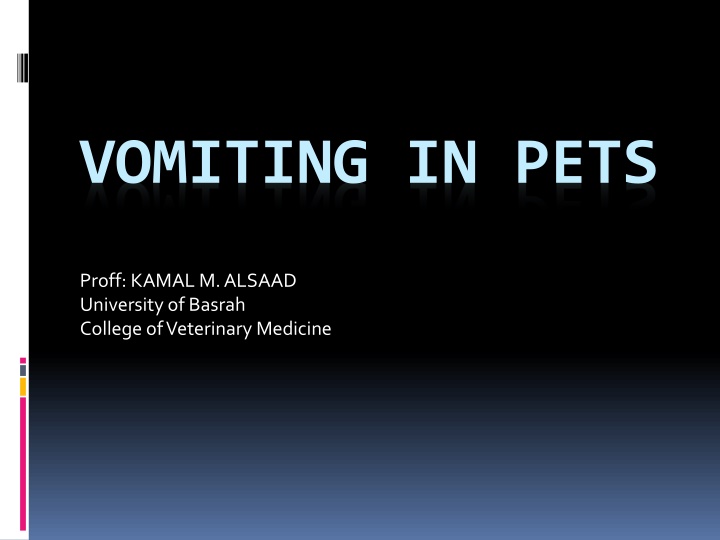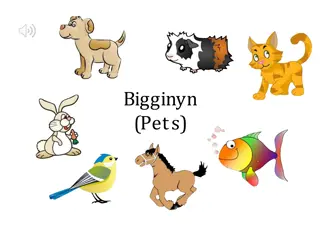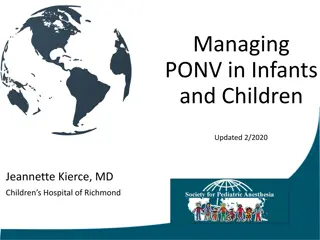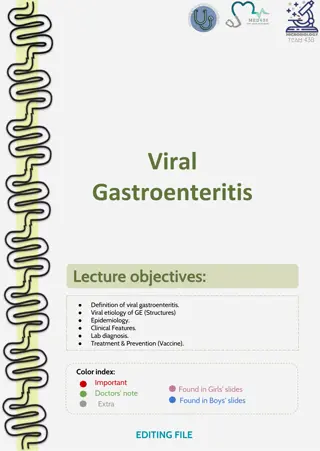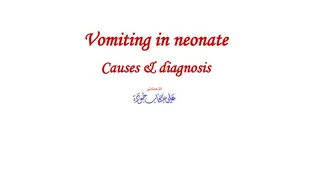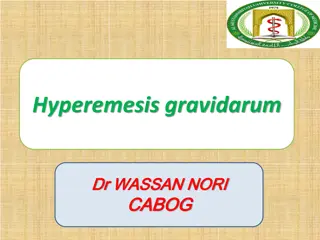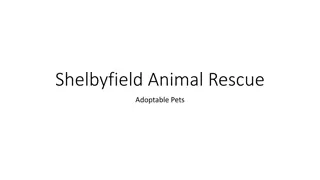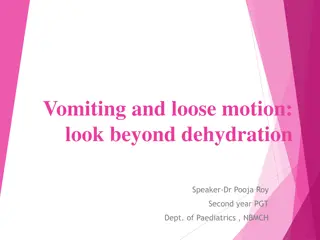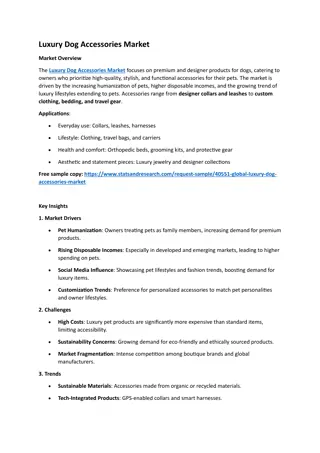VOMITING IN PETS
Emesis is a common presenting sign in small animal practice and requires a rational approach to management based on a sound understanding of pathophysiology. The reflex, controlled within the brainstem, consists of phases such as hypersalivation, retching, and expulsion. Mechanism of emesis involves the release of serotonin, and various chemicals can induce vomiting. General causes include gastritis, while infectious diseases like canine parvovirus and distemper, as well as other conditions, can also lead to vomiting in pets.
Download Presentation

Please find below an Image/Link to download the presentation.
The content on the website is provided AS IS for your information and personal use only. It may not be sold, licensed, or shared on other websites without obtaining consent from the author.If you encounter any issues during the download, it is possible that the publisher has removed the file from their server.
You are allowed to download the files provided on this website for personal or commercial use, subject to the condition that they are used lawfully. All files are the property of their respective owners.
The content on the website is provided AS IS for your information and personal use only. It may not be sold, licensed, or shared on other websites without obtaining consent from the author.
E N D
Presentation Transcript
VOMITING IN PETS Proff: KAMAL M. ALSAAD University of Basrah College of Veterinary Medicine
Emesis is a common presenting sign in small animal practice. It requires a rational approach to management that is based upon a sound understanding of pathophysiology combined with logical decision making. Emesis is facilitated by a sequence of programmed overlapping and coordinated events which reduce the risks of adverse consequences (such as aspiration of acid stomach contents) whilst achieving elimination.
The reflex is controlled within the brainstem by a central pattern generator, loosely termed the vomiting centre The reflex has visible phases of hypersalivation, retching and expulsion. Efferent pathways controlling these processes include the vagal and phrenic nerves, parasympathetic nerves to the salivary glands and somatic motor nerves to abdominal muscles
LES: Lower oesophageal sphincter. UES: Upper oesophageal sphincter
Mechanism of emesis Release of 5 hydroxytryptamine/serotonin (5 HT) from enterochromaffin cells, which have been demonstrated in canine and feline gastric and duodenal mucosa, stimulates vagal afferents via 5 HT3receptors Numerous chemicals, that can induce emesis when administered systemically, also do so via direct application to the area postrema. These include apomorphine, xylazine, prostaglandins and various hormones and peptides.
General causes of vomiting Gastritis . Lymphoplasmacytic Granulomatous Acute Gastric neoplasia Gastric ulceration Ruptured diaphragm Gastric dilatation/volvulus Pyloric stenosis Foreign body Dietary
Infectious disease Canine parvovirus Canine distemper virus Canine coronavirus Salmonellosis Campylobacteriosis Fungal infection Hookworms/Roundworms Inflammatory bowel diseases Intestinal neoplasia, Intussusception,Intestinal volvulus
Other causes . Such as Disease of nervous system Peritonitis Hepatobiliary disease Splenic diseases Pancreatic diseases Renal diseases Urogenital diseases such as Pyometritis, Endometritis and Urethrolithiasis Uraemia Ketoacidosis Hepatic encephalopathy Septicaemia and Toxicity
Consequences and complications of emesisinclude Emesis is associated with signs of Nausea Depression Salivation Lip licking Increased swallowing motions Loss of appetite Those signs will leads to Dehydration , hypovolaemic shock, acid base and electrolyte disturbances , aspiration pneumonia which can be life threatening
How to evaluated emetic animal. Cardiovascular and hydration status, including mucous membrane color, capillary refill time, Heart and pulse rate, rhythm and strength Evaluation of Body temperature Presence of halitosis oral cavity Halitosis can be an indicator for the presence of necrosis in the oral cavity, pharynx or oesophagus, e.g. due to a foreign body or necrosis of the salivary gland Evaluation of Body condition &Weight loss & examination of
Presence and localization of abdominal pain, and masses Presence of free abdominal fluid Presence and nature of any vaginal discharge Color or vomitus Green vomit .. Ingestion of a large quantity of grass Yellow vomit it will consist mainly of bile due mainly of empty stomach Black vomit This is rare. Typically, black vomit could be a sign of mud or dirt that the pet digested accidently while they were playing. If black vomit has a similar appearance to coffee granules, if you find that it s actually a very, very dark red, this may be a sign of a stomach ulcer or an undigested toxin.
White vomitmight due to Guttural inflammation of gastric mucus membrane or bloat with appearance of a foam Red vomit Red vomit is usually a sign that the pet is vomiting blood. If the blood is fresh (a normal shade of red), this could mean trouble with the lining of their stomach or possible inflammation; alternatively, vomiting blood could be a response to a poisonous substance. Dark brown vomit *Groans* especially if it smells strongly, is a sign that the pet has ingested too much poo. It can also be a sign that there s a blockage in their intestines.
Diagnostic tests used in the investigation of dogs with emesis Liver biopsy, evaluation of liver enzyme activity and/or bile acid concentration, total protein, abnormal appearance of liver on ultrasound Endoscopy Fecal examination Urinalysis Complete blood count,Lipid profile, Electrolytes Evaluation of blood glucoses & calcium Evaluation of Pancreatic enzymes Ultrasounds and x ray
Treatment . 1- prevent the primary cause 2-Antiemetics such as Acepromazine: 0.01 0 05 mg/kg i.m., or s.c. 1 3 mg/kg Chlorpromazine: 0.5 mg/kg i.m., s.c.for 6 8h Metoclopramide( plasil ) 0.2 0.5 mg/kg i.m., s.c., p.o. for 6 8h Maropitant: standard emesis 1mg/kg s.c. every 24h. For prevention of motion sickness up to 8mg/kg p.o. for 24h for maximum of 2 days Diphenhydramine 4 mg / animal orally
3-Systemic antibiotics ,,,such as Gentamicin Enroflaxcisin 4-diatary management 5-Fluid and electrolytes therapy
